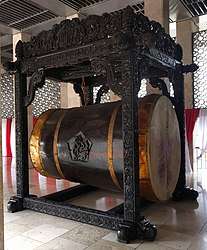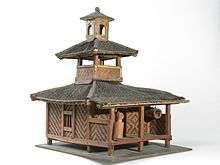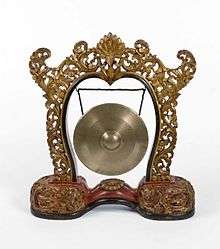Bedug
The bedug (Indonesian: beduk; Javanese: bedhug) is one of the drums used in the gamelan. It is used among Muslims in Java for religious purposes.[1][2]
 A bedug in Istiqlal mosque, Jakarta. | |
| Percussion instrument | |
|---|---|
| Other names | Beduk, Bedhug |
| Classification | Membranophone |
| Hornbostel–Sachs classification | 211.212.1 (Cylindrical drum) |
| Developed | Indonesia |
Overview
A bedug is a large double-barreled drum[1] with water buffalo leather on both sides.[2]
Unlike the more frequently used kendang, the bedug is suspended from a rack and played with a padded mallet and is not adjustable. The bedug is as large or larger than the largest kendang and generally has a deeper and duller sound. The drum has pegs holding the two identical heads in place similar to the Japanese taiko.
Usage
The bedug is not used in most gamelan performances. It is used in special ensembles like the gamelan sekaten, where it takes the place of the kempul.[3] In some pieces it is played along with the kendang, especially to accompany dancing.
The bedug is commonly used in mosques in Java among Javanese and Sundanese people to precede the adhan as a sign for prayer[4] or during Islamic festivals.[1] For example, the sound of a bedug is used to signal the end of the daylong fast during Ramadan and sometimes it is used to signal time for Suhoor during Ramadan[5]. When used to signal time for Friday prayer, the bedug is beaten in a different way than for ordinary prayers[2]. The bedug is also used to celebrate takbiran, the night before Eid ul-Fitr when people chant takbir and hit the bedug in Indonesian Lebaran tradition.
See also
Notes
- Rasmussen, Anne K. (2010). Women, the Recited Qur'an, and Islamic Music in Indonesia. University of California Press. ISBN 978-0-520-25549-4.
- Muhaimin, Abdul Ghoffir (2006). The Islamic traditions of Cirebon: ibadat and adat among Javanese Muslims. ANU E Press. ISBN 978-1-920942-30-4.
- Lindsay, Jennifer. Javanese Gamelan. Oxford: Oxford UP, 1979. ISBN 0-19-580413-9. Page 47.
- George, Kenneth M. (2010). Picturing Islam: Art and Ethics in a Muslim Lifeworld. John Wiley and Sons. p. 77. ISBN 978-1-4051-2957-2.
- Ramadan and Lebaran in Indonesia



